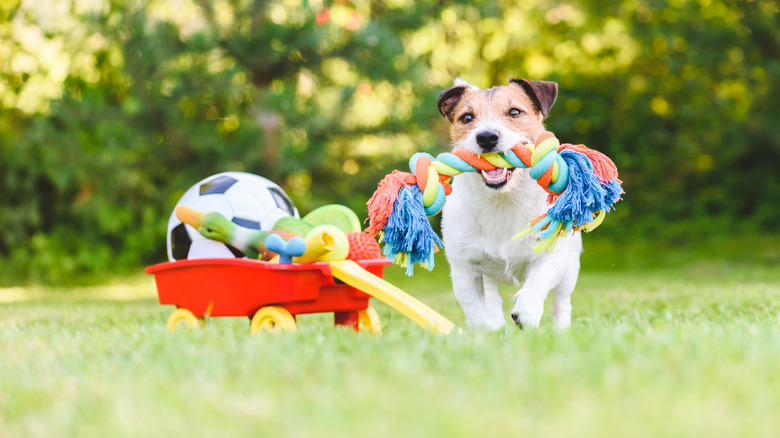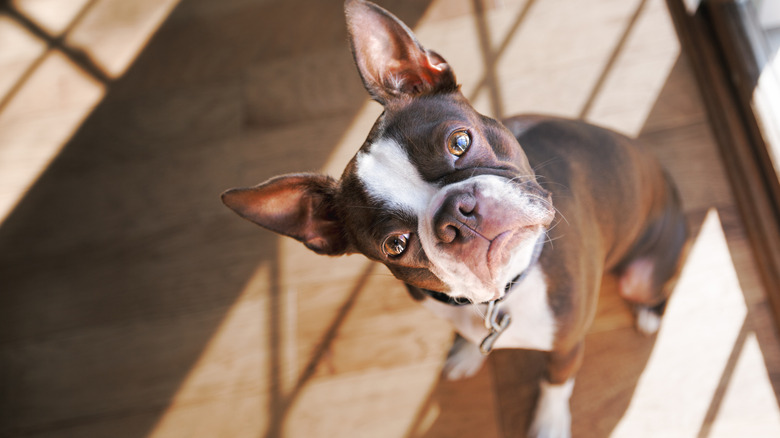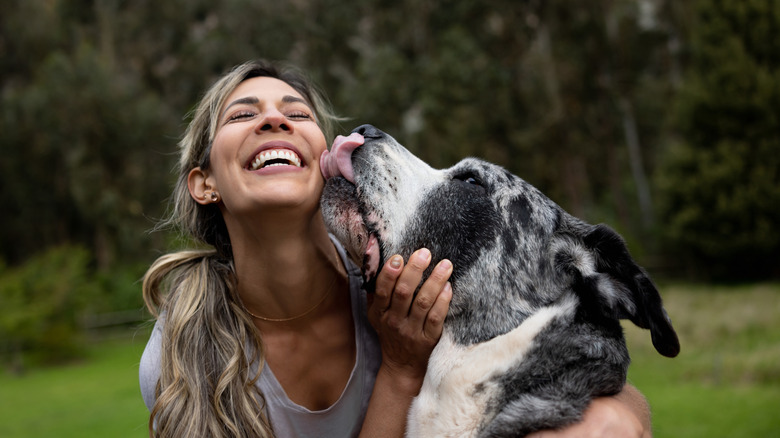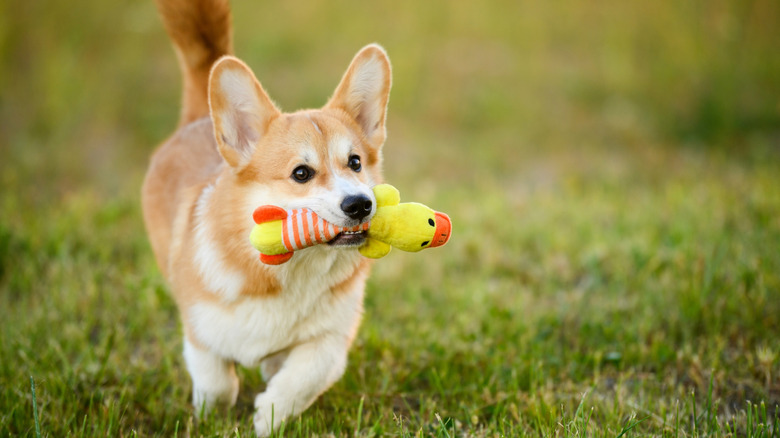The Funniest Dog Behaviors (And Possible Meanings Behind Them)
We may receive a commission on purchases made from links.
Our canine companions are such curious creatures. One moment, understanding their wants and needs seems so simple, only for them to turn around and perform a silly action out of nowhere the next. Dogs warm our hearts with their antics, but they also provide plenty of humor. These moments also make fond memories to cherish; you never forget the excitement of a puppy's first bout of the zoomies.
Pet parents get to experience countless funny dog behaviors, like tail chasing or hiding their favorite toy where you can still see it. As caretakers, we want to find meaning in our pets' actions as much as appreciate them for the adorableness of simple gestures like a head tilt. Yet, we don't always understand exactly why they do what they do, with some canine behaviors leaving even scientists baffled.
Tilting their heads
Our furry friends certainly have ways of showing their attentiveness to our every move, and the connection we make with them through speech is just one of the many ways to bond. One of the cuter reactions that results from talking to a dog is the infamous head tilt, which makes it appear as though they are trying their best to pick up on every word we utter. However, the motivation behind this seemingly small action is more complex than it seems.
A 2021 study led by Dr. Andrea Sommese at the Eötvös Loránd University in Hungary concluded that the canine head tilt may not only stem from our pets trying to hear us better but also be about reacting to stimuli and information processing. The research showed that exceptionally gifted dogs (able to remember multiple toys) tilted their heads more frequently when communicating with their caretakers. In these tests, the dogs would consistently tilt their head one way, regardless of where the human speaker was standing, hinting that the direction may be based on personal preference.
The head tilt can be a sign of intelligence, affection, and, in some cases, such as with breeds with floppy ears, a means of better hearing their caretaker. Social pups are also more likely to tilt their heads. The side tilt is adorable, but if your dog tilts their head often without stimulus, this could point to an ear infection.
Zoomies
Is there anything more exciting than a dog with a major case of the zoomies, that sudden rush of energy that has you guessing whether they will go left or right, spin in circles, or jump around all of the furniture? It is certainly a fun chaos. The zoomies can manifest right after a bath, after a bowel movement, or out of nowhere.
The excitement after a bath can be a whirlwind of hair and water spraying the walls. The reason for the burst of energy after a soak may vary based on your pup. Those who love baths may be riding a wave of happiness, while those who treat the act like the end of the world are simply excited to escape the water. Other potential factors include the desire to dry off, get the scent of shampoo off of them, and return to their natural smell by rubbing against everything.
Since the zoomies can arise seemingly unprompted, the reason behind them remains debated. Some have speculated that the zoomies are a natural release of pent-up energy, while others think they tap into a canine's instinctual behavior, showing their prowess and establishing their territory. How cute is it to picture a little pug channeling his ancient ancestors by running amok?
Staring
There you are, sitting at your desk or perhaps lounging on the couch, and you notice your furry friend out of the corner of your eye giving you an adorable look. You are now engaged in a stare-down. Who will blink first? Do you smile or narrow your eyes in a humorous display of friendly competition to see who can hold their gaze the longest? More importantly, why is your dog staring at you in the first place?
A long stare from your pup can signify a few different things, but mostly, they want your attention. Whether it is because they are looking for food, a cue to head out for the much-cherished walk, or are just curious about where you are at in life, a dog may make prolonged eye contact. Starring can also be a sign of aggression, so as cute as it is at first to lock gazes, don't stare too long. It can make them uncomfortable; instead, try to figure out what they want from you. What about when your dog stares at you when they poop, though? In this case, your pup may desire to make sure you've got their back while they are in a vulnerable position. It's also possible that they're after a reward for their good behavior.
Spinning
Dogs can be so theatrical. Seeing them spin in excess feels like they are putting on quite the show as they try to make themselves comfortable or find the perfect spot to pee or poop. In the case of going potty, your dog is probably just playing it safe, ensuring they are on even ground before they perform the deed. Other theories suggest canines spin a little to maximize the spread of their scent.
Other cases of spinning, however, can be a sign of underlying issues. If you find that your dog is spinning excessively or circling while showing symptoms of anxiety, it is best to check in with your vet. Some breeds will also spin more than others, with the Japanese Chin known for its infamous "Chin spin." These dogs react to stimuli by whirling in excitement. Don't worry, the Japanese Chin was bred to entertain nobles, and it is in their genes to please with their quirky behavior.
Making a nest
If you allow your dog to sleep in the bed with you, you've probably had your covers stolen at some point as your pup crafts a little nest for themselves. This process can take time, and it certainly seems deliberate on their part. It's undeniably adorable, and likely to result in little more than a minor inconvenience on a cold day when you end up surrendering your blanket to your pet. However, while dogs who create nests are doing their best to get comfortable, there may be additional motivations behind this behavior.
For female dogs, nesting can indicate pregnancy or a false pregnancy. Pregnancy comes with nurturing instincts, and making a proper bed for the expected puppies is a natural manifestation of this. However, if nesting becomes excessive and comes with signs of anxiety, it is best to speak with your vet. If you suspect that your dog is pregnant or experiencing a phantom pregnancy, you will also want to schedule an exam, as both can come with health concerns.
Licking the air
With food just out of reach, you may have looked over at your pooch and seen them licking the air. Dogs certainly want to eat whatever you are having, and licking the air is a way for canines to get a better taste of a potential treat. This occurs due to the presence of what is known as the Jacobson's organ on the roof of their mouth, which enhances scents when they lap up air with their tongue.
Some pet parents may also notice their doggo licks away when receiving a scratch or pet in their favorite spot. This is because licking the air can also be a sign of affection and excitement. It is a funny yet cute behavior that you can just enjoy, although if it becomes excessive, it may point to larger issues, like anxiety, an upset tummy, or discomfort in their mouth. On the flip side, those who have ever treated their dog with almond or peanut butter (always go sugar and xylitol-free) can see their tongues do overtime.
Howling
From a little awoo to a big boastful wail, a howling dog is adorable no matter their size and sound. This curious behavior traces back to their wild ancestors, as wolves use howling to communicate their location, stay safe, and even as a way to show affection for their pack. But when it comes to your modern doggo, why do they still feel the need to let out a howl?
Scientists believe that dogs also howl to communicate, even if it is just for an audience of one. Other times, dogs use their howl to express happiness, anxiety, or discomfort from an injury. Of course, if you find the behavior utterly adorable and they expect praise and a treat, you better believe they will howl for your attention. This behavior may be most humorous when your dog replies to a siren, which is likely just them encountering a familiar sound and responding in kind to say hello or trying to protect their pack.
Licking skin
Getting a little lick from your dog can come as a surprise; some people like it, and some find it gross, to each their own. But where do these little (or big) dog kisses come from, and what do they mean? The simplest answer is you are tasty! You may notice your dog licking you when you are sweaty, but spilled food or lotions can also turn your pooch into a curious lapper.
Dogs will lick your skin for other reasons, so don't just think you are naturally delicious to your pooch. Licking is a sign of love and care dogs extend to their companions, similar to how a mother cleans her pups. The act of licking is comforting to dogs (though we don't recommend you lick them back), and they are likely tapping into those good vibes when they give you kisses. At the same time, licking can be a sign of anxiety, and if they lick themselves obsessively, this could indicate neurological problems or discomfort from allergies, an injury, or issues with their teeth.
Play bowing
When your dog bows toward you, lowering their chest but keeping their behind raised, it is a sign that they are ready to play. Whether you start a game of tag or throw a ball for them, this simple little gesture says a lot about your dog's mood. You can also play bow in return, either getting on their level or moving your upper body and mimicking the action, to bond with your pooch and have some additional fun.
Play bowing is even more heartwarming when dogs use it to greet each other. This action is a social cue your pup uses to signal not only that they are ready to play, but that they will do so in a fair manner. You can see this often when your dog interacts with their fellow canines. Simply put, your pup is making a little peace offering that the rough housing will remain safe and fun when they bow to a familiar or new friend. Still, it is always important to keep an eye on dogs when playing, as one pet's energy can be too aggressive for the other.
Tail chasing
Tail chasing has long been one of those doggo behaviors that has been seen as charming, a moment of confusion that becomes the butt of the joke in movies or TV. In the case of puppies, the little cuties are just starting to understand their bodies, with the mysterious appendage being more of a toy. You don't really need to worry in this case; instead, enjoy the chaos until they tucker themselves out.
However, tail chasing in adult dogs often signifies boredom and a desire for attention. In this case, try to redirect that energy into a positive action. A dog puzzle toy from makers like KADTC Intelligence Development can help keep their minds busy. Alternatively, taking them out on more walks or finding activities to do together is a great way to bond and burn off any boredom. If a dog won't stop chasing their tail, it is best to bring them to the vet, as this can indicate an underlying medical issue.
Kicking the ground after pooping
Your dog has just done their business, and there you are doing the proper thing as a responsible pet parent and picking up after them. How does your pup thank you? By kicking up dirt and grass into your face. This action may make you chuckle, as you know they likely aren't doing it on purpose. The motivation behind this funny occurence is also pretty straightforward, so you can't fault their eccentric behavior.
While many people think dogs kick after pooping in an effort to bury their waste, they are actually scent marking. Letting other doggos in the area know that they were there, whether to mark their territory or exchange information, is common practice. You may have even observed this yourself, with your dog giving a more vigorous display of kicking prowess when another canine is in the area. You can train dogs not to kick up grass after pooping or peeing if you want to minimize the damage to your lawn.
Hoarding their toys
Canines aren't always the greatest sharers, a fact that anyone in a multi-pet household can tell you. Dogs often play favorites when it comes to toys, and they may be hesitant to give them up. The bonds they form with everything from a cute plushy to a dirty old shoe and their desire to hide or bury these objects may leave you perplexed, and the reasons behind these actions are numerous.
The simplest answer is that your dog is guarding their possessions by hiding them, a natural survival instinct they carry from their ancestors; yes, that soggy rawhide pulled from beneath the cushions was intentionally placed there, they assure you. Whether you want your pooch to keep this habit or not is up to you; you can train them at a young age not to hoard their toys. If you don't mind their greedy attitudes towards their favorite possessions, just keep an eye out for changes, excessive hoarding, or resource guarding, as these can be signs of anxiety or phantom pregnancy and lead to safety issues.
Sticking their head out of the car window
Some dogs seem born for a life on the road given the amount of energy that comes with their anticipation of a car ride. For these pups, zipping by the scenery with their head out of the window offers a rush of excitement bolstered by scents, sights, and sounds. While the experience may be fun for your dog (and it is certainly adorable to see their hair flowing in the wind), it's best to avoid this particular humorous behavior.
A lot can potentially go wrong with a dog loose in the car. Your pup could impede the driver or, in the worst case scenario, end up getting hurt in an accident. Your best bet is to get a backseat cover and seat belt to ensure your dog stays safe. If you are more of a freewheeler and enjoy cruising on your motorcycle, you may want to pick up a pair of QUMY dog sunglasses to keep your canine's eyes protected.
Resting on your feet
Is there anything cuter than a dog coming up to you only to plop themselves on your feet? Or better yet, when lying down, you suddenly feel the soft weight of their head as they rest it against you. For humans, this results in the release of feel-good vibes (oxytocin), but what do our furry friends get out of it?
When your dog rests on your feet or another part of your body, they are likely feeling affectionate; the language of cuddles is pretty universal. Other reasons for snuggly behavior can be as simple as they are cold or looking for attention. A dog at your feet or by your side is always a heartwarming sensation, but be mindful of how much they find comfort there and how they act. Excessive cuddles could be a sign of stress; if they are shaky, panting, or seem generally uncomfortable, ask your vet for advice for managing their stress or anxiety.
Excited sneezing
A series of little sneezes that make for a hilarious face is one of the many humorous occurrences pet parents get to witness. When we sneeze, it is normally because of allergies or a cold, but our pooches seem to sneeze at peculiar times. With dogs exploring the world through scents, it is not uncommon for them to sneeze when they take in too many smells, but an excited sneeze is something else altogether.
Much like the play bow, excited sneezing can be a signal of fair play, a little tiny noise to diffuse a tense situation between dogs. Of course, excessive or messy sneezing, like in people, can be a sign of illness or allergies. Sneezing can also come with respiratory issues, such as the common kennel cough. Some dog breeds are also prone to reverse sneezing (quickly taking air into the nose instead of expelling it). This situation typically does not require treatment from a vet but can confuse a new pet parent.



